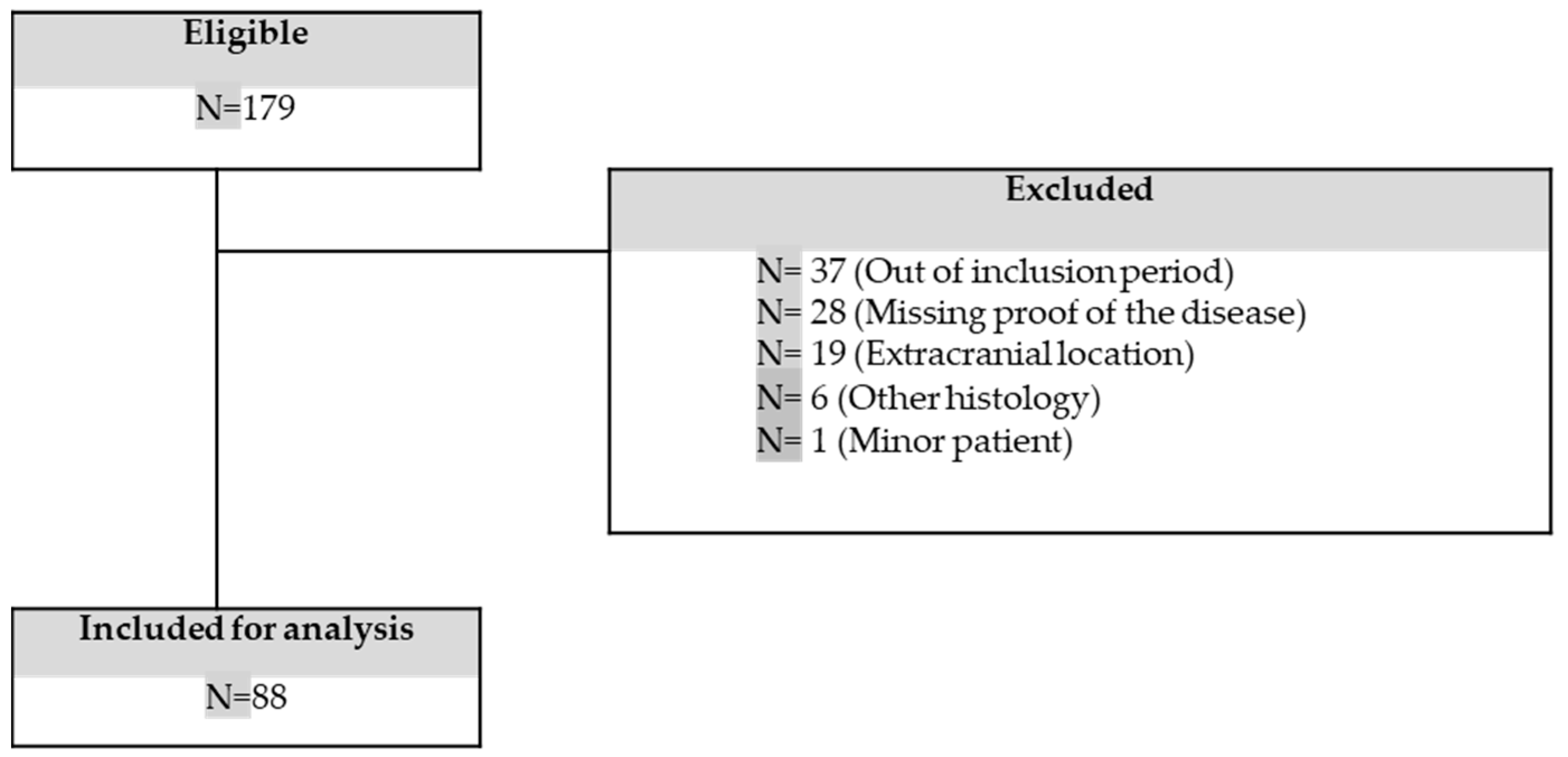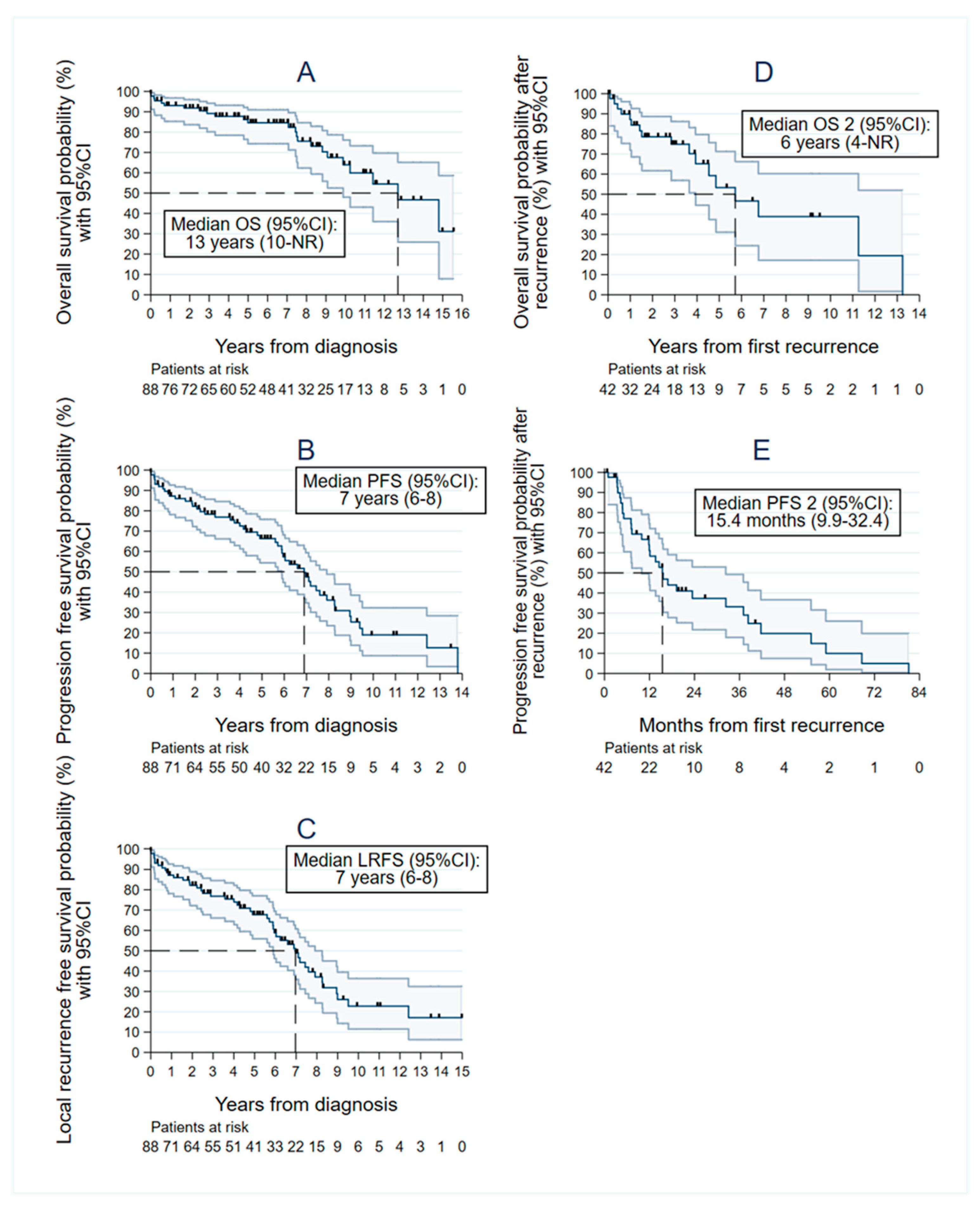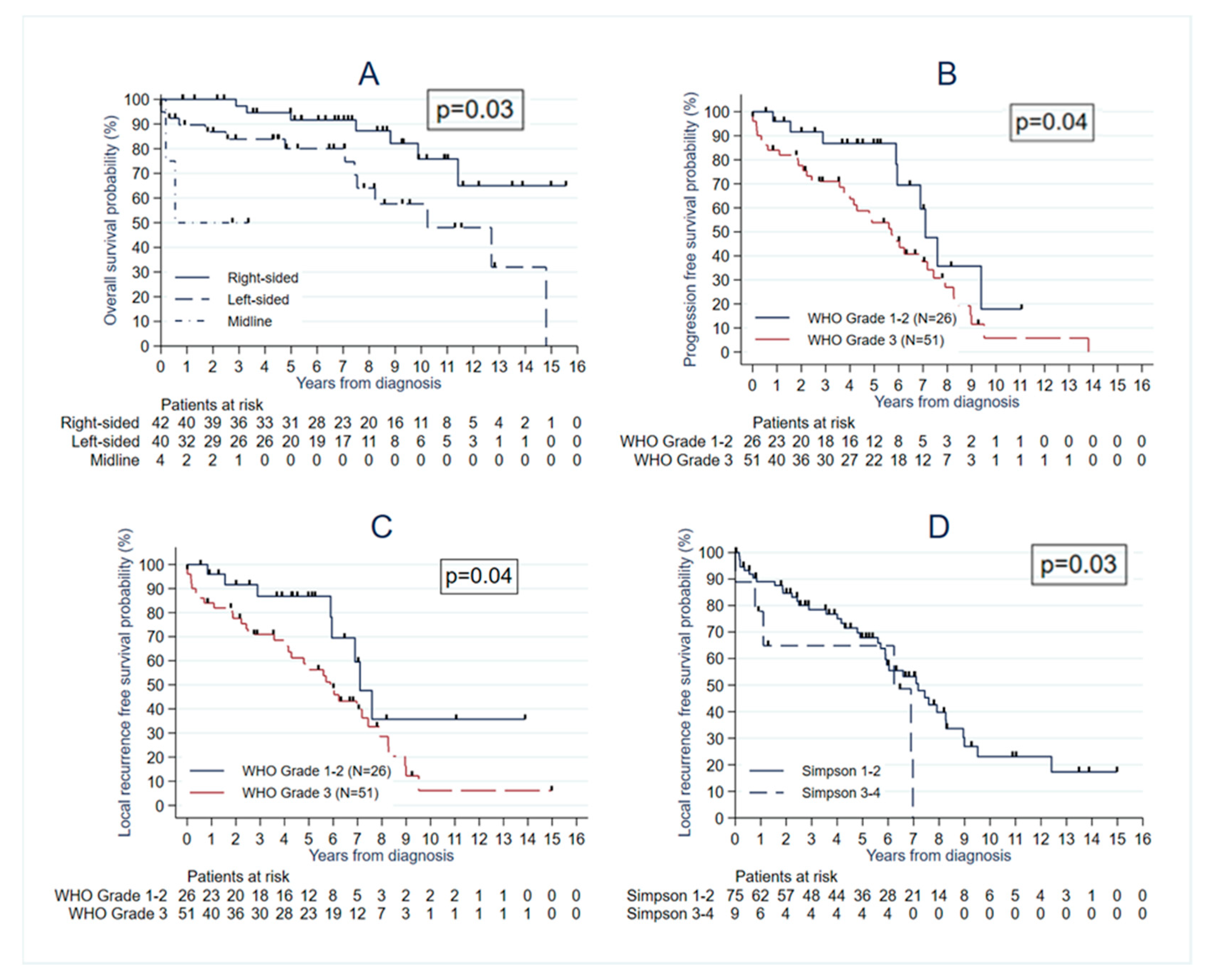Intracranial Solitary Fibrous Tumour Management: A French Multicentre Retrospective Study
Abstract
:Simple Summary
Abstract
1. Introduction
2. Materials and Methods
2.1. Case Selection
2.2. Pathology
2.3. Statistical Analyses
2.4. Ethical Approval
3. Results
3.1. Patient Characteristics
3.2. Clinical and Pathological Presentation
3.3. Initial Treatment
3.4. Survival Analyses
3.5. Recurrences and Treatment at Recurrence
3.6. Extracranial Metastasis
3.7. Prognosis Factors
4. Discussion
5. Conclusions
6. Suggested Recommendations Resulting from Our Clinical Experience
Supplementary Materials
Author Contributions
Funding
Institutional Review Board Statement
Informed Consent Statement
Data Availability Statement
Acknowledgments
Conflicts of Interest
References
- Cohen-Inbar, O. Nervous System Hemangiopericytoma. Can. J. Neurol. Sci. J. Can. des Sci. Neurol. 2019, 47, 18–29. [Google Scholar] [CrossRef]
- Kim, B.S.; Kim, Y.; Kong, D.-S.; Nam, D.-H.; Lee, J.-I.; Suh, Y.-L.; Seol, H.J. Clinical outcomes of intracranial solitary fibrous tumor and hemangiopericytoma: Analysis according to the 2016 WHO classification of central nervous system tumors. J. Neurosurg. 2018, 129, 1384–1396. [Google Scholar] [CrossRef] [Green Version]
- Darlix, A.; Zouaoui, S.; Rigau, V.; Bessaoud, F.; Figarella-Branger, D.; Mathieu-Daudé, H.; Trétarre, B.; Bauchet, F.; Duffau, H.; Taillandier, L.; et al. Epidemiology for primary brain tumors: A nationwide population-based study. J. Neuro-Oncology 2016, 131, 525–546. [Google Scholar] [CrossRef] [PubMed]
- Macagno, N.; Vogels, R.; Appay, R.; Colin, C.; Mokhtari, K.; Küsters, B.; Wesseling, P.; Figarella-Branger, D.; Flucke, U.; Bouvier, C.; et al. Grading of meningeal solitary fibrous tumors/hemangiopericytomas: Analysis of the prognostic value of theMarseilleGradingSystem in a cohort of 132 patients. Brain Pathol. 2018, 29, 18–27. [Google Scholar] [CrossRef] [PubMed] [Green Version]
- Louis, D.N.; Perry, A.; Wesseling, P.; Brat, D.J.; Cree, I.A.; Figarella-Branger, D.; Hawkins, C.; Ng, H.K.; Pfister, S.M.; Reifenberger, G.; et al. The 2021 WHO Classification of Tumors of the Central Nervous System: A summary. Neuro-Oncology 2021, 23, 1231–1251. [Google Scholar] [CrossRef] [PubMed]
- Kim, J.H.; Jung, H.-W.; Kim, Y.-S.; Kim, C.J.; Hwang, S.-K.; Paek, S.H.; Kim, D.G.; Kwun, B.D. Meningeal hemangiopericytomas: Long-term outcome and biological behavior. Surg. Neurol. 2003, 59, 47–53, discussion 53. [Google Scholar] [CrossRef]
- Dufour, H.; Métellus, P.; Fuentes, S.; Murracciole, X.; Régis, J.; Figarella-Branger, D.; Grisoli, F. Meningeal Hemangiopericytoma: A Retrospective Study of 21 Patients with Special Review of Postoperative External Radiotherapy. Neurosurgery 2001, 48, 756–763. [Google Scholar] [CrossRef]
- Martin-Broto, J.; Cruz, J.; Penel, N.; Le Cesne, A.; Hindi, N.; Luna, P.; Moura, D.S.; Bernabeu, D.; de Alava, E.; Lopez-Guerrero, J.A.; et al. Pazopanib for treatment of typical solitary fibrous tumours: A multicentre, single-arm, phase 2 trial. Lancet Oncol. 2020, 21, 456–466. [Google Scholar] [CrossRef]
- Rutkowski, M.J.; Bloch, O.; Jian, B.J.; Chen, C.; Sughrue, M.E.; Tihan, T.; Barani, I.J.; Berger, M.S.; McDermott, M.W.; Parsa, A.T. Management of recurrent intracranial hemangiopericytoma. J. Clin. Neurosci. 2011, 18, 1500–1504. [Google Scholar] [CrossRef]
- Soyuer, S.; Chang, E.L.; Selek, U.; McCutcheon, I.E.; Maor, M.H. Intracranial meningeal hemangiopericytoma: The role of radiotherapy: Report of 29 cases and review of the literature. Cancer 2004, 100, 1491–1497. [Google Scholar] [CrossRef]
- Chamberlain, M.C.; Glantz, M.J. Sequential salvage chemotherapy for recurrent intracranial hemangiopericytoma. Neurosurgery 2008, 63, 720–727. [Google Scholar] [CrossRef]
- Guthrie, B.L.; Ebersold, M.J.; Scheithauer, B.W.; Shaw, E.G. Meningeal Hemangiopericytoma: Histopathological Features, Treatment, and Long-Term Follow-up of 44 Cases. Neurosurgery 1989, 25, 514–522. [Google Scholar] [CrossRef] [PubMed]
- Rutkowski, M.J.; Sughrue, M.E.; Kane, A.J.; Aranda, D.; Mills, S.A.; Barani, I.J.; Parsa, A.T. Predictors of mortality following treatment of intracranial hemangiopericytoma: Clinical article. J. Neurosurg. 2010, 113, 333–339. [Google Scholar] [CrossRef] [PubMed]
- Stessin, A.M.; Sison, C.; Nieto, J.; Raifu, M.; Li, B. The Role of Postoperative Radiation Therapy in the Treatment of Meningeal Hemangiopericytoma—Experience From the SEER Database. Int. J. Radiat. Oncol. Biol. Phys. Biol. Phys. 2013, 85, 784–790. [Google Scholar] [CrossRef]
- Wang, W.; Zhang, G.-J.; Zhang, L.-W.; Li, D.; Wu, Z.; Zhang, J.-T. Long-Term Outcome and Prognostic Factors After Repeated Surgeries for Intracranial Hemangiopericytomas. World Neurosurg. 2017, 107, 495–505. [Google Scholar] [CrossRef] [PubMed]
- Schiariti, M.; Goetz, P.; El-Maghraby, H.; Tailor, J.; Kitchen, N.D. Hemangiopericytoma: Long-term outcome revisited. Clinical article. J. Neurosurg. 2011, 114, 747–755. [Google Scholar] [CrossRef]
- Chen, L.-F.; Yang, Y.; Yu, X.-G.; Gui, Q.-P.; Xu, B.-N.; Zhou, D.-B. Multimodal treatment and management strategies for intracranial hemangiopericytoma. J. Clin. Neurosci. 2015, 22, 718–725. [Google Scholar] [CrossRef]
- Lottin, M.; Escande, A.; Peyre, M.; Sevestre, H.; Maurage, C.A.; Chauffert, B.; Penel, N. What’s new in the management of meningeal solitary fibrous tu-mor/hemoangioperctyoma? Bull. du Cancer 2020, 107, 1260–1273. [Google Scholar] [CrossRef]
- Jääskeläinen, J.; Servo, A.; Haltia, M.; Wahlström, T.; Valtonen, S. Intracranial hemangiopericytoma: Radiology, surgery, radiotherapy, and outcome in 21 patients. Surg. Neurol. 1985, 23, 227–236. [Google Scholar] [CrossRef]
- Melone, A.G.; D’Elia, A.; Santoro, F.; Salvati, M.; Delfini, R.; Cantore, G.; Santoro, A. Intracranial Hemangiopericytoma—Our Experience in 30 Years: A Series of 43 Cases and Review of the Literature. World Neurosurg. 2013, 81, 556–562. [Google Scholar] [CrossRef]
- Combs, S.E.; Thilmann, C.; Debus, J.; Schulz-Ertner, D. Precision radiotherapy for hemangiopericytomas of the central nervous system. Cancer 2005, 104, 2457–2465. [Google Scholar] [CrossRef] [PubMed]
- Cohen-Inbar, O.; Lee, C.-C.; Mousavi, S.H.; Kano, H.; Mathieu, D.; Meola, A.; Nakaji, P.; Honea, N.; Johnson, M.; Abbassy, M.; et al. Stereotactic radiosurgery for intracranial hemangiopericytomas: A multicenter study. J. Neurosurg. 2017, 126, 744–754. [Google Scholar] [CrossRef] [PubMed] [Green Version]
- Lee, J.H.; Jeon, S.H.; Park, C.K.; Park, S.H.; Yoon, H.I.; Chang, J.H.; Suh, C.O.; Kang, S.J.; Lim, D.H.; Kim, I.A.; et al. The Role of Postoperative Radiotherapy in Intracranial Solitary Fibrous Tumor/Hemangiopericytoma: A Multi-Institutional Ret-rospective Study (KROG 18-11). Cancer Res. Treat. 2022, 54, 65–74. [Google Scholar] [CrossRef] [PubMed]
- Xiao, J.; Xu, L.; Ding, Y.; Wang, W.; Chen, F.; Zhou, Y.; Zhang, F.; Zhou, Q.; Wu, X.; Li, J.; et al. Does post-operative radiotherapy improve the treatment outcomes of intracranial hemangiopericytoma? A retrospective study. BMC Cancer 2021, 21, 1–10. [Google Scholar] [CrossRef] [PubMed]
- Fountas, K.N.; Kapsalaki, E.; Kassam, M.; Feltes, C.H.; Dimopoulos, V.G.; Robinson, J.S.; Smith, J.R. Management of intracranial meningeal hemangiopericytomas: Outcome and experience. Neurosurg. Rev. 2006, 29, 145–153. [Google Scholar] [CrossRef] [PubMed]
- Kumar, N.; Kumar, R.; Kapoor, R.; Ghoshal, S.; Kumar, P.; Salunke, P.S.; Radotra, B.D.; Sharma, S.C. Intracranial meningeal hemangiopericytoma: 10 years experience of a tertiary care Institute. Acta Neurochir. 2012, 154, 1647–1651. [Google Scholar] [CrossRef]
- Fyllingen, E.H.; Bø, L.E.; Reinertsen, I.; Jakola, A.S.; Sagberg, L.M.; Berntsen, E.M.; Salvesen, Ø.; Solheim, O. Survival of glioblastoma in relation to tumor location: A statistical tumor atlas of a population-based cohort. Acta Neurochir. 2021, 163, 1895–1905. [Google Scholar] [CrossRef]
- Park, M.S.; Patel, S.R.; Ludwig, J.A.; Trent, J.C.; Conrad, C.A.; Lazar, A.J.; Wang, W.-L.; Boonsirikamchai, P.; Choi, H.; Wang, X.; et al. Activity of temozolomide and bevacizumab in the treatment of locally advanced, recurrent, and metastatic hemangiopericytoma and malignant solitary fibrous tumor. Cancer 2011, 117, 4939–4947. [Google Scholar] [CrossRef]
- Bastin, K.T.; Mehta, M.P. Meningeal hemangiopericytoma: Defining the role for radiation therapy. J. Neuro-Oncology 1992, 14, 277–287. [Google Scholar] [CrossRef]
- Beadle, C.F.; Hillcoat, B.L. Treatment of advanced malignant hemangiopericytoma with combination adriamycin and dtic: A report of four cases. J. Surg. Oncol. 1983, 22, 167–170. [Google Scholar] [CrossRef]
- De Lemos, M.L.; Kang, I.; Schaff, K. Efficacy of bevacizumab and temozolomide therapy in locally advanced, recurrent, and metastatic malignant solitary fibrous tumour: A population-based analysis. J. Oncol. Pharm. Pract. 2018, 25, 1301–1304. [Google Scholar] [CrossRef] [PubMed]
- Lackner, H.; Urban, C.; Schwinger, W.; Kerbl, R.; Sovinz, P. Interferon alfa-2a in recurrent metastatic hemangiopericytoma. Med Pediatr. Oncol. 2003, 40, 192–194. [Google Scholar] [CrossRef] [PubMed]
- Kirn, D.H.; Kramer, A. Long-Term Freedom From Disease Progression With Interferon Alfa Therapy in Two Patients With Malignant Hemangiopericytoma. Gynecol. Oncol. 1996, 88, 764–765. [Google Scholar] [CrossRef] [PubMed]



| Characteristics (N = 88) | n (%) |
|---|---|
| Sex | |
| Female | 50 (57%) |
| Male | 38 (43%) |
| Median age (range) | 54.5 (19–88) |
| Mean age (SD) | 51.5 (16.4) |
| STAT6 expression (immunohistochemistry) | |
| Yes | 34 (39%) |
| No | 0 (0%) |
| Not available | 54 (61%) |
| The WHO histoprognostic grade | |
| Grade 1 | 1 (1%) |
| Grade 2 | 25 (28%) |
| Grade 3 | 51 (58%) |
| Not available | 11 (13%) |
| Mitotic count | |
| <5 | 36 (41%) |
| ≥5 | 45 (51%) |
| Not available | 7 (8%) |
| Necrosis | |
| Yes | 33 (38%) |
| No | 55 (63%) |
| Number of lesions | |
| Unique | 84 (95%) |
| Multiple | 4 (5%) |
| Maximal diameter | |
| < 3cm | 5 (6%) |
| 3–5 cm | 24 (27%) |
| ≥5 cm | 32 (36%) |
| Not available | 27 (30%) |
| Topography of the tumour | |
| Right-sided | 42 (48%) |
| Left-sided | 40 (45%) |
| Midline * | 4 (4%) |
| Bilateral | 1 (1%) |
| Not available | 1 (1%) |
| Location | |
| Supratentorial | 71 (81%) |
| Infratentorial | 17 (17%) |
| Supra- and infratentorial | 2 (2%) |
| Preoperative embolization | |
| Yes | 8 (9%) |
| No | 80 (91%) |
| Resection grade according to Simpson | |
| Simpson 1–2 (gross tumour resection) | 75 (85%) |
| Simpson 3–4 (subtotal tumour resection) | 9 (10%) |
| Simpson 5 (biopsy) | 1 (1%) |
| Not available | 3 (3%) |
| Postoperative radiotherapy (N = 56) | |
| Yes | 32 (57%) |
| No | 24 (43%) |
| Technique of radiotherapy | |
| Conformational radiotherapy Radiosurgery Not available | 19 (50%) 3 (9%) 10 (31%) |
| Local control | |
| Yes | 76 (86%) |
| No | 11 (13%) |
| Not available | 1 (1%) |
| Type of treatment (N = 65) | |
| Surgery alone | 33 (51%) |
| Radiotherapy alone | 1 (1%) |
| Surgery plus postoperative radiotherapy | 31 (48%) |
| Characteristics (N = 37) | n (%) |
|---|---|
| Unifocal recurrence | |
| Yes | 32 (87%) |
| No | 5 (14%) |
| Maximal diameter of recurrence | |
| <3 cm | 19 (51%) |
| 3–5 cm | 5 (14%) |
| ≥5 cm | 2 (5%) |
| Not available | 11 (30%) |
| Recurrence topography | |
| Right-sided | 18 (49%) |
| Left-sided | 16 (43%) |
| Midline | 3 (8%) |
| Bilateral | 0 (0%) |
| Recurrence location | |
| Supratentorial | 30 (81%) |
| Infratentorial | 7 (19%) |
| Supra- and infratentorial | 0 (0%) |
| Preoperative embolization | |
| Yes | 0 (0%) |
| No | 37 (100%) |
| Preoperative radiotherapy | |
| Yes | 1 (3%) |
| No | 36 (97%) |
| Surgery | |
| Yes | 17 (46%) |
| No | 20 (54%) |
| Resection grade according to Simpson (N = 17) | |
| Simpson 1–2 (gross tumour resection) | 15 (88%) |
| Simpson 3–4 (subtotal tumour resection) | 1 (6%) |
| Not available | 1 (6%) |
| Postoperative radiotherapy (N = 17) | |
| Yes | 10 (59%) |
| No | 7 (41%) |
| Type of radiotherapy | |
| Conformational radiotherapy Radiosurgery Not available | 4 (40%) 4 (40%) 2 (20%) |
| Exclusive radiotherapy | |
| Yes | 14 (38%) |
| No | 23 (62%) |
| Technique of radiotherapy | |
| Conformational radiotherapy Radiosurgery Not available | 2 (14%) 8 (57%) 4 (29%) |
| Chemotherapy associated with radiotherapy | |
| Yes | 1 (3%) |
| No | 36 (97%) |
| Postoperative chemotherapy | |
| Yes | 1 (3%) |
| No | 36 (97%) |
| Local control after treatment | |
| Yes | 26 (70%) |
| No | 10 (27%) |
| Not available | 1 (3%) |
| Type of treatment that led to control (N = 26) | |
| Surgery alone | 4 (15%) |
| Radiotherapy alone | 11 (42%) |
| Surgery and postoperative radiotherapy | 11 (42%) |
| Chemotherapy alone | 0 (0%) |
| Radiotherapy and postoperative chemotherapy | 0 (0%) |
| No treatment | 0 (0%) |
| Characteristics | Overall Survival | Progression-Free Survival | Local Recurrence-Free Survival | |||||||||
|---|---|---|---|---|---|---|---|---|---|---|---|---|
| Univariate HR (95% CI) | p | Multivariate HR (95% CI) | P | Univariate HR (95% CI) | p | Multivariate HR (95% CI) | P | Univariate HR (95% CI) | p | Multivariate HR (95% CI) | p | |
| Sex | 0.78 | 0.36 | 0.60 | |||||||||
| Female | 1 | 1 | 1 | |||||||||
| Male | 0.89(0.39–2.02) | 0.76 (0.43–1.36) | 0.85(0.48–1.53) | |||||||||
| Age * | 1.05(1.02–1.09) | 0.003 | 1.04(1.01–1.08) | 0.01 | 1.03 (1.01–1.05) | 0.003 | 1.03(1.01–1.05) | 0.008 | 1.03(1.01–1.05) | 0.002 | 1.04(1.01–1.06) | 0.002 |
| Signs of raised intracranial pressure $ (n = 85) | 1.30(0.53–3.17) | 0.57 | 0.95(0.48–1.89) | 0.89 | 0.99(0.50–1.97) | 0.98 | ||||||
| Motor deficit $ (n = 85) | 1.56 (0.63–3.84) | 0.34 | 1.34 (0.71–2.51) | 0.37 | 1.28 (0.67–2.44) | 0.46 | ||||||
| Sensory deficit $ (n = 85) | 1.11 (0.26–4.80) | 0.89 | 0.90 (0.32–2.51) | 0.84 | 0.95 (0.34–2.66) | 0.92 | ||||||
| Epileptic seizures *$ (n = 85) | 0.22 (0.03–1.66) | 0.14 | 0.37 (0.13–1.03) | 0.056 | 0.40 (0.14–1.11) | 0.08 | ||||||
| High-function disorder *$ (n = 85) | 1.65 (0.72–3.78) | 0.23 | 1.52 (0.86–2.70) | 0.15 | 1.52 (0.85–2.73) | 0.16 | ||||||
| Visual disorder $ (n = 85) | 0.60 (0.20–1.77) | 0.35 | 0.95 (0.50–1.81) | 0.88 | 1.02 (0.53–1.95) | 0.95 | ||||||
| Cerebellar syndrome *$ (n = 86) | 1.83 (0.67–5.00) | 0.24 | 1.78 (0.83–3.86) | 0.14 | 1.86 (0.86–4.02) | 0.12 | ||||||
| Headache $ (n = 85) | 1.00 (0.43–2.33) | 1.00 | 0.97 (0.54–1.73) | 0.91 | 0.83 (0.46–1.50) | 0.54 | ||||||
| Mitotic count ≥5 *$ (n = 81) | 1.47 (0.62–3.48) | 0.38 | 2.03 (1.07–3.85) | 0.03 | 2.36 (1.21–4.63) | 0.01 | ||||||
| Necrosis $ | 1.25 (0.56–2.81) | 0.59 | 1.15 (0.65–2.06) | 0.63 | 1.15 (0.64–2.07) | 0.65 | ||||||
| WHO grade (n = 77) | 0.29 | 0.047 | 0.04 | 0.03 | 0.03 | |||||||
| Grade 1–2 | 1 | 1 | 1 | |||||||||
| Grade 3 | 1.76 (0.58–5.28) | 2.05 (0.98–4.28) | 2.14 (1.03–4.78) | 2.21 (1.02–4.79) | 2.36 (1.08–5.16) | |||||||
| Max. diameter (n = 61) | 0.83 | 0.79 | 0.74 | |||||||||
| < 3 cm | 1 | 1 | 1 | |||||||||
| 3–5 cm | 1.73(0.18–228.92) | 1.96(0.25–15.16) | 1.94(0.25–15.00) | |||||||||
| ≥5 cm | 2.20(0.27–285.32) | 1.70(0.22–12.93) | 1.55(0.20–11.85) | |||||||||
| Topography *(n = 87) | 0.004 | 0.03 | 0.003 | 0.002 | ||||||||
| Right-sided | 1 | 1 | 1 | 1 | ||||||||
| Left-sided * | 3.02(1.21–7.52) | 2.69(1.07–6.81) | 1.84 (1.01–3.37) | 2.03 (1.10–3.76) | ||||||||
| Midline * | 13.86(2.54–75.71) | 8.29(1.42–48.50) | 8.57(2.32–31.65) | 9.08(2.44–33.73) | ||||||||
| Location | 0.94 | 0.70 | 0.62 | |||||||||
| Supratentorial | 1 | 1 | 1 | |||||||||
| Infratentorial | 0.96 (0.32–2.84) | 1.15 (0.55–2.40) | 1.20 (0.58–2.51) | |||||||||
| Preoperative embolization *$ | 0.25 (0.002–1.82) | 0.35 | 0.08 (0.001–0.55) | 0.08 | 0.09 (0.001–0.60) | 0.09 | ||||||
| Resection grade * (n = 84) | 0.04 | 0.12 | 0.10 | 0.03 | ||||||||
| Simpson 1–2 | 1 | 1 | 1 | 1 | 1 | |||||||
| Simpson 3–4 | 3.20 (1.04–9.83) | 2.02 (0.84–4.89) | 2.11 (0.87–5.12) | 3.00 (1.09–8.24) | ||||||||
| PORT $ (n = 56) | 0.88 (0.34–2.29) | 0.80 | 0.50 (0.26–0.97) | 0.04 | 0.56 (0.29–1.10) | 0.10 | ||||||
Disclaimer/Publisher’s Note: The statements, opinions and data contained in all publications are solely those of the individual author(s) and contributor(s) and not of MDPI and/or the editor(s). MDPI and/or the editor(s) disclaim responsibility for any injury to people or property resulting from any ideas, methods, instructions or products referred to in the content. |
© 2023 by the authors. Licensee MDPI, Basel, Switzerland. This article is an open access article distributed under the terms and conditions of the Creative Commons Attribution (CC BY) license (https://creativecommons.org/licenses/by/4.0/).
Share and Cite
Lottin, M.; Escande, A.; Bauchet, L.; Albert-Thananayagam, M.; Barthoulot, M.; Peyre, M.; Boone, M.; Zouaoui, S.; Guyotat, J.; Penchet, G.; et al. Intracranial Solitary Fibrous Tumour Management: A French Multicentre Retrospective Study. Cancers 2023, 15, 704. https://doi.org/10.3390/cancers15030704
Lottin M, Escande A, Bauchet L, Albert-Thananayagam M, Barthoulot M, Peyre M, Boone M, Zouaoui S, Guyotat J, Penchet G, et al. Intracranial Solitary Fibrous Tumour Management: A French Multicentre Retrospective Study. Cancers. 2023; 15(3):704. https://doi.org/10.3390/cancers15030704
Chicago/Turabian StyleLottin, Marine, Alexandre Escande, Luc Bauchet, Marie Albert-Thananayagam, Maël Barthoulot, Matthieu Peyre, Mathieu Boone, Sonia Zouaoui, Jacques Guyotat, Guillaume Penchet, and et al. 2023. "Intracranial Solitary Fibrous Tumour Management: A French Multicentre Retrospective Study" Cancers 15, no. 3: 704. https://doi.org/10.3390/cancers15030704






